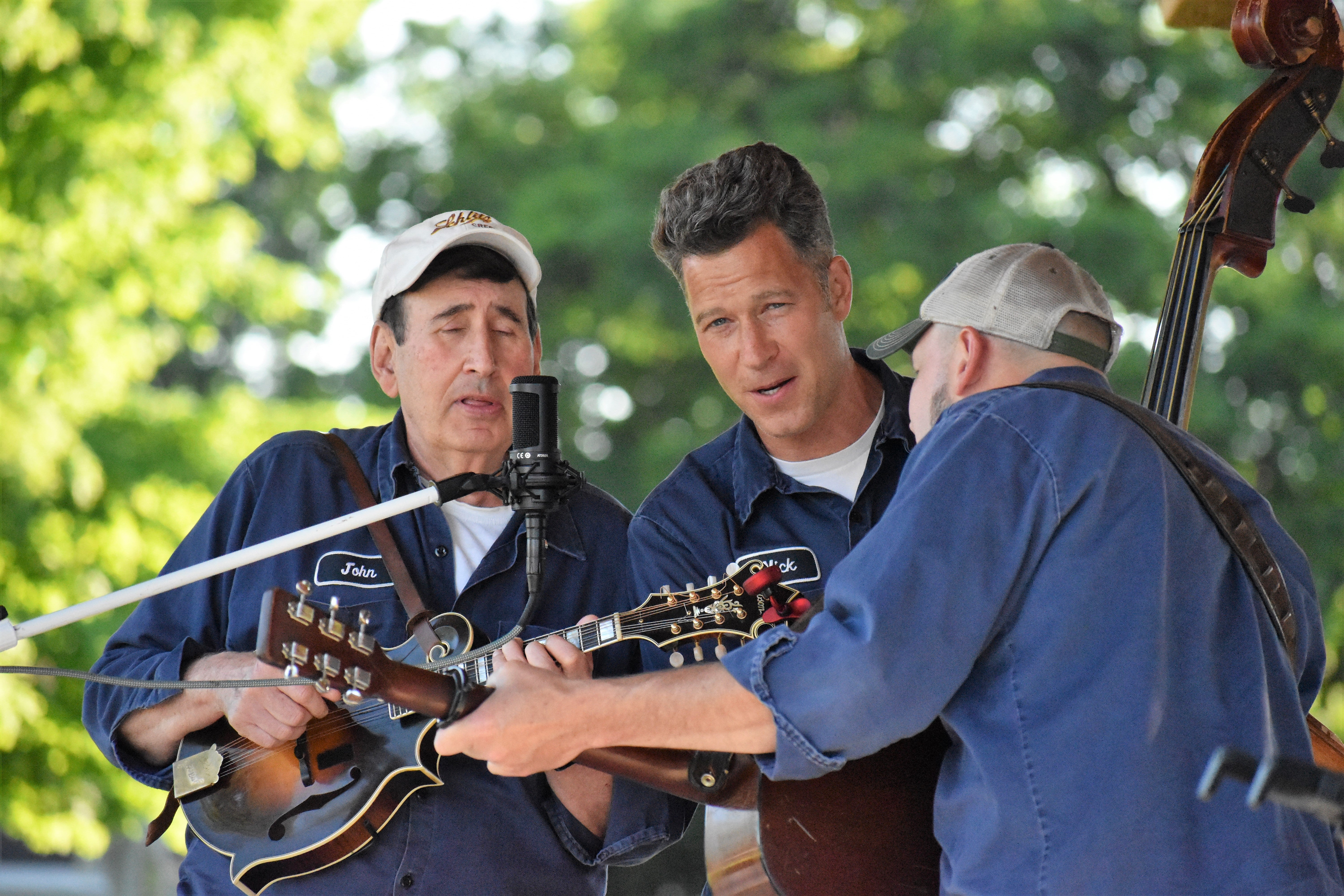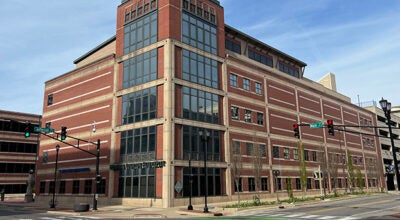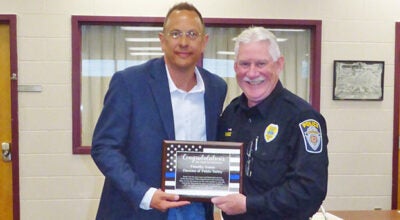Classical concert celebrates 150th anniversary at St. Paul’s
Published 10:02 am Monday, November 9, 2009

St. Paul's music director, Linda Mack, who performed on organ and harpsichord, as well as singing chamber music with Canto Dulcis, basks in a standing ovation with Venezuelan violinist Claudio Gonzalez, who conducts the Andrews University Sinfonietta in the background, and flutist Katie Lewis. Their concert Sunday night filled 150-year-old St. Paul's Episcopal Church, Dowagiac.'s oldest public building and a Michigan historic site designated in 1984. (The Daily News/John Eby)
By JOHN EBY
Dowagiac Daily News
Justus Gage gathered the first congregation in the 1850s for the Universalist church built on land Patrick Hamilton and his wife, Lovina, owned.
In 1865, Dowagiac’s oldest public building draped itself all in black to mourn Abraham Lincoln’s assassination. Even the choir donned black robes.
In 1965, the parish house was used to interview candidates for Southwestern Michigan College president and prospective SMC architects.
The Rev. William Patrick Dillon O’Leary, born in Cleveland, was a founding trustee for whom SMC named its original administration building.
He served on the college board for 10 years.
Father O’Leary served St. Paul’s the longest, 22 years, from 1954 until he retired to Fairplain in 1976. He died Jan. 11, 1984.
Sunday night St. Paul’s Episcopal Church celebrated 150 years with a concert combining Venezuelan violinist Claudio Gonzalez and the Andrews University Sinfonietta he conducts; organist Linda Mack, who also turned in a virtuoso harpsichord performance; and another California native, Katie Lewis, on flute.
Music performed spanned the ages, from Mozart, Handel and Bach’s “Brandenburg Concerto No. 5” to the second worldwide production of “Psalm 121 for Organ and Strings” with St. Joseph composer James Kraus listening in the sanctuary.
To replicate the feeling of the mid-19th century, Canto Dulcis – literally “sweet singing” in Italian – sang the Shaker tune “I Will Bow and Be Simple,” a quartet of American folk hymns which might have been heard at the Universalist church in the days of singing schools, “Palmetto (Shall We Gather at the River),” “Shining Shore,” “Where We’ll Never Grow Old” and “Just Over in the Gloryland” and the early American hymn “Wondrous Love.”
“Males lived to an average age of 38,” Mack said.
“Females were lucky if they survived childbirth. You can imagine, looking forward to Gloryland was an important thing to think about.”
Mack grew up in the San Francisco Bay area, where she began formal music instruction at age 6, studying piano, organ and brass instruments. She took up harpsichord in college at Andrews University in Berrien Springs.
She moved to Salt Lake City, Utah, where she produced a weekly radio program of organ music.
In 1987, Mack completed a master’s degree in library science from Brigham Young University. She returned to Michigan and joined Andrews, where she has been music librarian since 1993. Mack is St. Paul’s music director.
Gonzalez directs orchestral studies at Andrews. Between 1978 and 1981 he studied violin at the Royal College of Music in London.
His 1994 master’s degree in violin performance and 2003 doctorate in orchestral conducting are from Michigan State University.
Gonzalez has played under such conductors as Leonard Bernstein, Michael Tilson-Thomas, Seiji Ozawa, Lorin Maazel and George Solti.
He taught in Venezuela from 1995 to 1999.
Since joining Andrews in 2004, Gonzalez has led the university orchestra in a regular concert series at Howard Performing Arts Center and on international tours of Europe and the Philippines.
Lewis, who began playing flute at 5, was born in California and raised in Michigan. She is completing an animal science degree specializing in equine breeding and reproduction management and looks forward to graduating in December from MSU.
When they weren’t singing chamber music, Julia Lindsay, Linda Mack and Asta LaBianca took turns at the harpsichord.
St. Paul’s, complete with the city’s first pipe organ, from Boston, served as Dowagiac’s auditorium in the way Central and the middle school Performing Arts Center would in later years, hosting speakers, performers and music recitals.
“Everything that happened in town happened right here,” said The Rev. Richard R. Swanson, rector since March 2006. “Because of the railroad, all political figures who came through stopped in Dowagiac. They listened to people like Victoria Woodhull, Sojourner Truth and Susan B. Anthony. These walls have heard thousands of words.”
In 1958, the (northeast) corner of the church burned and was rebuilt 50 years ago.
In 2008, St. Paul’s color schemes were redesigned to reflect the Byzantine period.
Also in attendance was retired rector the Rev. Robert A. Smith.
The first recorded Episcopal service in town took place in a private home in 1858.
Services conducted by itinerant priests traveling through the area continued in homes.
In 1897, Trinity Church of Niles loaned its rector for regular services in Dowagiac held at first in the public library.
The first known Episcopal service in the Universalist church was on Feb. 16, 1897.
The Bishop of Western Michigan visited twice that year, baptizing 10 people and presiding at the Eucharist. In May, the congregation organized as a mission, St. Alban’s.
Early enthusiasm waned, however, and finances became a problem.
When the priest resigned in 1901 to take another position, St. Alban’s Mission dissolved.
Visiting clergy continued to provide occasional services to Dowagiac Episcopalians until 1911, when another rector of Trinity Church in Niles renewed holding weekly services at Dowagiac’s public library.
Later that year, the congregation again organized as a mission, this time choosing St. Paul as patron saint.
The group leased the Universalist church and held Sunday afternoon services.
The thriving congregation gained parish status at the June 8, 1912, diocesan convention.
In 1913, the new parish purchased the building from the Universalist Society.
St. Paul’s experienced the ups and downs of any small parish.
Most early rectors stayed only a few years before moving on – sometimes with gaps between them.
The building was maintained and modernized, but there were constant financial challenges.
The building exterior has remained essentially the same until today.
Twenty-five years ago, in 1984, the building was designated a state historical site with an appropriate marker erected in front of St. Paul’s on Courtland Street.






